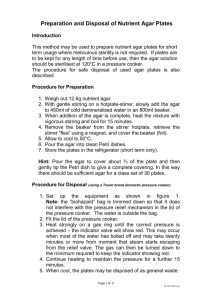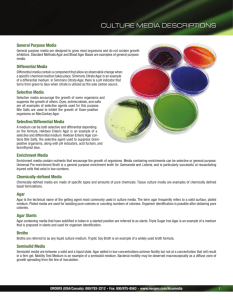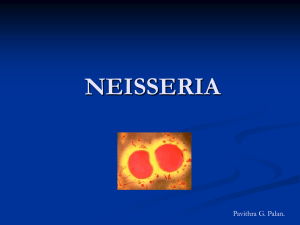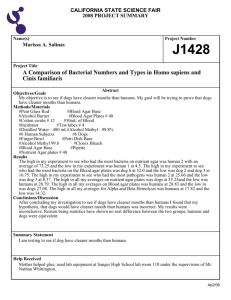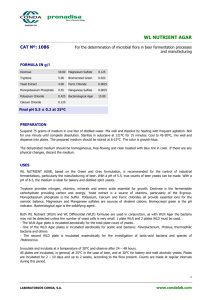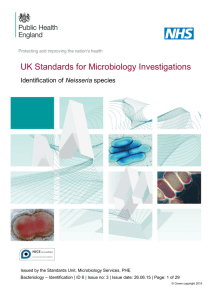BBL™ Thayer-Martin Selective Agar
advertisement
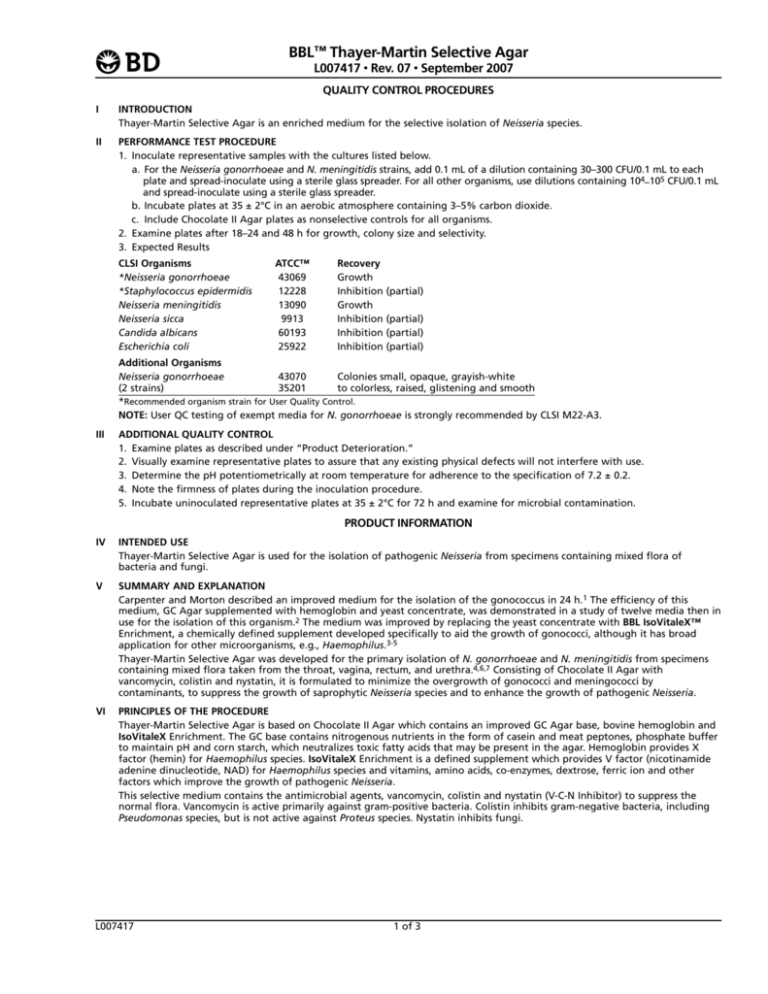
% BBL™ Thayer-Martin Selective Agar L007417 • Rev. 07 • September 2007 QUALITY CONTROL PROCEDURES I INTRODUCTION Thayer-Martin Selective Agar is an enriched medium for the selective isolation of Neisseria species. II PERFORMANCE TEST PROCEDURE 1. Inoculate representative samples with the cultures listed below. a. For the Neisseria gonorrhoeae and N. meningitidis strains, add 0.1 mL of a dilution containing 30–300 CFU/0.1 mL to each plate and spread-inoculate using a sterile glass spreader. For all other organisms, use dilutions containing 104–105 CFU/0.1 mL and spread-inoculate using a sterile glass spreader. b. Incubate plates at 35 ± 2°C in an aerobic atmosphere containing 3–5% carbon dioxide. c. Include Chocolate II Agar plates as nonselective controls for all organisms. 2. Examine plates after 18–24 and 48 h for growth, colony size and selectivity. 3. Expected Results CLSI Organisms *Neisseria gonorrhoeae *Staphylococcus epidermidis Neisseria meningitidis Neisseria sicca Candida albicans Escherichia coli ATCC™ 43069 12228 13090 9913 60193 25922 Recovery Growth Inhibition Growth Inhibition Inhibition Inhibition (partial) (partial) (partial) (partial) Additional Organisms Neisseria gonorrhoeae 43070 Colonies small, opaque, grayish-white (2 strains) 35201 to colorless, raised, glistening and smooth *Recommended organism strain for User Quality Control. NOTE: User QC testing of exempt media for N. gonorrhoeae is strongly recommended by CLSI M22-A3. III ADDITIONAL QUALITY CONTROL 1. Examine plates as described under “Product Deterioration.” 2. Visually examine representative plates to assure that any existing physical defects will not interfere with use. 3. Determine the pH potentiometrically at room temperature for adherence to the specification of 7.2 ± 0.2. 4. Note the firmness of plates during the inoculation procedure. 5. Incubate uninoculated representative plates at 35 ± 2°C for 72 h and examine for microbial contamination. IV INTENDED USE Thayer-Martin Selective Agar is used for the isolation of pathogenic Neisseria from specimens containing mixed flora of bacteria and fungi. V SUMMARY AND EXPLANATION Carpenter and Morton described an improved medium for the isolation of the gonococcus in 24 h.1 The efficiency of this medium, GC Agar supplemented with hemoglobin and yeast concentrate, was demonstrated in a study of twelve media then in use for the isolation of this organism.2 The medium was improved by replacing the yeast concentrate with BBL IsoVitaleX™ Enrichment, a chemically defined supplement developed specifically to aid the growth of gonococci, although it has broad application for other microorganisms, e.g., Haemophilus.3-5 Thayer-Martin Selective Agar was developed for the primary isolation of N. gonorrhoeae and N. meningitidis from specimens containing mixed flora taken from the throat, vagina, rectum, and urethra.4,6,7 Consisting of Chocolate II Agar with vancomycin, colistin and nystatin, it is formulated to minimize the overgrowth of gonococci and meningococci by contaminants, to suppress the growth of saprophytic Neisseria species and to enhance the growth of pathogenic Neisseria. VI PRINCIPLES OF THE PROCEDURE Thayer-Martin Selective Agar is based on Chocolate II Agar which contains an improved GC Agar base, bovine hemoglobin and IsoVitaleX Enrichment. The GC base contains nitrogenous nutrients in the form of casein and meat peptones, phosphate buffer to maintain pH and corn starch, which neutralizes toxic fatty acids that may be present in the agar. Hemoglobin provides X factor (hemin) for Haemophilus species. IsoVitaleX Enrichment is a defined supplement which provides V factor (nicotinamide adenine dinucleotide, NAD) for Haemophilus species and vitamins, amino acids, co-enzymes, dextrose, ferric ion and other factors which improve the growth of pathogenic Neisseria. This selective medium contains the antimicrobial agents, vancomycin, colistin and nystatin (V-C-N Inhibitor) to suppress the normal flora. Vancomycin is active primarily against gram-positive bacteria. Colistin inhibits gram-negative bacteria, including Pseudomonas species, but is not active against Proteus species. Nystatin inhibits fungi. PRODUCT INFORMATION L007417 1 of 3 VII REAGENTS Thayer-Martin Selective Agar Approximate Formula* Per Liter Purified Water Pancreatic Digest of Casein ................................................7.5 Selected Meat Peptone........................................................7.5 Corn Starch ..........................................................................1.0 Dipotassium Phosphate ......................................................4.0 Monopotassium Phosphate ................................................1.0 g g g g g Sodium Chloride ................................................................5.0 Agar ..................................................................................12.0 Hemoglobin ....................................................................10.0 IsoVitaleX Enrichment ....................................................10.0 V-C-N Inhibitor ................................................................10.0 g g g mL mL *Adjusted and/or supplemented as required to meet performance criteria. IsoVitaleX Enrichment Approximate Formula* Per Liter Purified Water Vitamin B12 ..........................................................................0.01 L-Glutamine ........................................................................10.0 Adenine ................................................................................1.0 Guanine Hydrochloride........................................................0.03 p-Aminobenzoic Acid ..........................................................0.013 Nicotinamide Adenine Dinucleotide ..................................0.25 g g g g g g Thiamine Pyrophosphate ................................................0.1 Ferric Nitrate ....................................................................0.02 Thiamine Hydrochloride..................................................0.003 L-Cysteine Hydrochloride ..............................................25.9 L-Cystine ..........................................................................1.1 Dextrose ......................................................................100.0 g g g g g g *Adjusted and/or supplemented as required to meet performance criteria. V-C-N Inhibitor Formula Per One Milliliter Restored Solution Vancomycin..........................................................................300 µg Colistin ................................................................................750 µg Nystatin..............................................................................1250 units Warnings and Precautions: For in vitro Diagnostic Use. If excessive moisture is observed, invert the bottom over an off-set lid and allow to air dry in order to prevent formation of a seal between the top and bottom of the plate during incubation. Pathogenic microorganisms, including hepatitis viruses and Human Immunodeficiency Virus, may be present in clinical specimens. "Standard Precautions"8-11 and institutional guidelines should be followed in handling all items contaminated with blood and other body fluids. After use, prepared plates, specimen containers and other contaminated materials must be sterilized by autoclaving before discarding. Storage Instructions: On receipt, store plates in the dark at 2–8°C. Avoid freezing and overheating. Do not open until ready to use. Minimize exposure to light. Prepared plates stored in their original sleeve wrapping at 2–8°C until just prior to use may be inoculated up to the expiration date and incubated for recommended incubation times. Allow the medium to warm to room temperature before inoculation. Product Deterioration: Do not use plates if they show evidence of microbial contamination, discoloration, drying, cracking or other signs of deterioration. VIII SPECIMEN COLLECTION AND HANDLING Specimens suitable for culture may be handled using various techniques. For detailed information, consult appropriate texts.12,13 Specimens should be obtained before antimicrobial therapy has been administered. Provision must be made for prompt delivery to the laboratory. IX PROCEDURE Material Provided: Thayer-Martin Selective Agar Materials Required But Not Provided: Ancillary culture media, reagents, quality control organisms and laboratory equipment as required. Test Procedure: Observe aseptic techniques. The agar surface should be smooth and moist, but without excessive moisture. Streak the specimen as soon as possible after it is received in the laboratory. Alternatively, if material is being cultured directly from a swab, proceed as follows:14 1. Roll swab directly on the medium in a large “Z” to provide adequate exposure of swab to the medium for transfer of organisms. 2. Cross-streak the “Z” pattern with a sterile wire loop, preferably in the clinic. If not done previously, cross-streaking should be done in the laboratory. 3. Place the culture as soon as possible in an aerobic environment enriched with 3–5% carbon dioxide. 4. Incubate at 35 ± 2°C and examine after overnight incubation and again after approximately 48 h. 5. Subculture for identification of N. gonorrhoeae should be made within 18–24 h. User Quality Control: See “Quality Control Procedures.” Quality Control requirements must be performed in accordance with applicable local, state and/or federal regulations or accreditation requirements and your laboratory’s standard Quality Control procedures. It is recommended that the user refer to pertinent CLSI (formerly NCCLS) guidance and CLIA regulations for appropriate Quality Control practices. X RESULTS Typical colonial morphology on Thayer-Martin Selective Agar is as follows: Neisseria gonorrhoeae ..................Small, grayish-white to colorless, mucoid Neisseria meningitidis ..................Medium to large, blue-gray, mucoid Colonies may be selected for Gram staining, subculturing or other diagnostic procedures. L007417 2 of 3 XI LIMITATIONS OF THE PROCEDURE Selective media for pathogenic Neisseria may inhibit other pathogenic bacteria, e.g., Haemophilus. The existence of strains of N. gonorrhoeae inhibited by the components of V-C-N Inhibitor have been reported.15 While “saprophytic” Neisseria are generally suppressed by selective media, the occasional recovery of N. lactamica on ThayerMartin Selective Agar has been reported.16 Some strains of Capnocytophaga species may grow on this selective medium when inoculated with oropharyngeal specimens.17 For identification, organisms must be in pure culture. Morphological, biochemical, and/or serological tests should be performed for final identification. Consult appropriate texts for detailed information and recommended procedures.12,13,18-21 A single medium is rarely adequate for detecting all organisms of potential significance in a specimen. It should be recognized that organisms generally susceptible to the antimicrobial agent in a selective medium may be completely or only partially inhibited depending upon the concentration of the agent, the characteristics of the microbial strain and the number of organisms in the inoculum. Organisms that are generally resistant to the antimicrobial agent should not be inhibited. Cultures of specimens grown on selective media should, therefore, be compared with specimens cultured on nonselective media to obtain additional information and help ensure recovery of potential pathogens. XII AVAILABILITY Cat. No. 221184 221282 Description BBL™ Thayer-Martin Selective Agar, Pkg. of 20 plates BBL™ Thayer-Martin Selective Agar, Ctn. of 100 plates XIII REFERENCES 1. 2. 3. 4. 5. 6. 7. 8. 9. 10. 11. 12. 13. 14. 15. 16. 17. 18. 19. 20. 21. Carpenter, C.M., and H.E. Morton. 1947. An improved medium for isolation of the gonococcus in 24 hours. Proc. N.Y. State Assoc. Public Health Labs. 27:58-60. Carpenter, C.M., M.A. Bucca, T.C. Buck, E.P. Casman, C.W. Christensen, E. Crowe, R. Drew, J. Hill, C.E. Lankford, H.E. Morton, L.R. Peizer, C.I. Shaw, and J.D. Thayer. 1949. Evaluation of twelve media for the isolation of the gonococcus. Am. J. Syphil. Gonorrh. Venereal Diseases 33:164-176. Power, D.A. (ed.), and P.J. McCuen. 1988. Manual of BBL products and laboratory procedures, 6th ed. Becton Dickinson Microbiology Systems, Cockeysville, Md. Martin, J.E., T.E. Billings, J.F. Hackney, and J.D. Thayer. 1967. Primary isolation of N. gonorrhoeae with a new commercial medium. Public Health Rep. 82:361-363. Vastine, D.W., C.R. Dawson, I. Hoshiwara, C. Yonega, T. Daghfous, and M. Messadi. 1974. Comparison of media for the isolation of Haemophilus species from cases of seasonal conjunctivitis associated with severe endemic trachoma. Appl. Microbiol. 28:688-690. Thayer, J.D., and J.E. Martin, Jr. 1966. Improved medium selective for cultivation of N. gonorrhoeae and N. meningitidis. Pub. Health Rep. 81:559-562. Mitchell, M.S., D.L. Rhoden, and B.B. Marcus. 1966. Immunofluorescence techniques for demonstrating bacterial pathogens associated with cerebrospinal meningitis. III. Identification of meningococci from the nasopharynx of asymptomatic carriers. Am. J. Epidem. 83:74-85. National Committee for Clinical Laboratory Standards. 2001. Approved Guideline M29-A2. Protection of laboratory workers from occupationally acquired infections, 2nd ed. NCCLS, Wayne, PA. Garner, J.S. 1996. Hospital Infection Control Practices Advisory Committee, U.S. Department of Health and Human Services, Centers for Disease Control and Prevention. Guideline for isolation precautions in hospitals. Infect. Control Hospital Epidemiol. 17:53-80. U.S. Department of Health and Human Services. 1999. Biosafety in microbiological and biomedical laboratories, HHS Publication (CDC), 4th ed. U.S. Government Printing Office, Washington, D.C. Directive 2000/54/EC of the European Parliament and of the Council of 18 September 2000 on the protection of workers from risks related to exposure to biological agents at work (seventh individual directive within the meaning of Article 16(1) of Directive 89/391/EEC). Official Journal L262, 17/10/2000, p. 0021-0045. Murray, P.R., E.J. Baron, J.H. Jorgensen, M.A. Pfaller, and R.H. Yolken (ed.). 2003. Manual of clinical microbiology, 8th ed. American Society for Microbiology, Washington, D.C. Forbes, B.A., D.F. Sahm, and A.S. Weissfeld. 2002. Bailey and Scott's diagnostic microbiology, 11th ed. Mosby, Inc., St. Louis. Center for Disease Control. 1975. Criteria and techniques for the diagnosis of gonorrhea. U.S. Public Health Service, Atlanta. Cross, R.C., M.B. Hoger, R. Neibaur, B. Pasternack, and F.J. Brady. 1971. VCN-inhibited strains of Neisseria gonorrhoeae. HSMHA Health Rep. 86:990-992. Edberg, S.C. 1974. The growth of Neisseria lactamica on media selective for pathogenic Neisseriaceae. Am. J. Clin. Pathol. 62:445. Finegold, S.M., and W.J. Martin. 1982. Bailey and Scott’s diagnostic microbiology, 6th ed. The C.V. Mosby Co., St. Louis. Holt, J.G., N.R. Krieg, P.H.A. Sneath, J.T. Staley, and S.T. Williams (ed.). 1994. Bergey's Manual™ of determinative bacteriology, 9th ed. Williams & Wilkins, Baltimore. MacFaddin, J.F. 2000. Biochemical tests for identification of medical bacteria, 3rd ed. Lippincott Williams & Wilkins, Baltimore. Koneman, E.W., S.D. Allen, W.M. Janda, P.C. Schreckenberger, and W.C. Winn, Jr. 1997. Color atlas and textbook of diagnostic microbiology, 5th ed. Lippincott-Raven, Philadelphia. Isenberg, H.D. (ed.). 2004. Clinical microbiology procedures handbook, vol. 1, 2 and 3, 2nd ed. American Society for Microbiology, Washington, D.C. Becton, Dickinson and Company 7 Loveton Circle Sparks, Maryland 21152 USA 800-638-8663 ATCC is a trademark of the American Type Culture Collection. BD, BD Logo, BBL and IsoVitaleX are trademarks of Becton, Dickinson and Company. ©2007 BD. L007417 3 of 3


